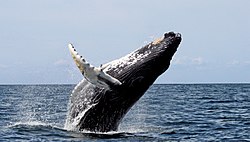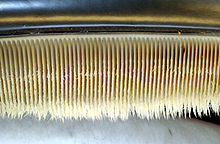Baleen whale: Difference between revisions
| Line 39: | Line 39: | ||
====Breaching==== |
====Breaching==== |
||
In spite of their enormous [[mass]], baleen whales are able to leap completely out of the water. Particularly known for their acrobatics are the [[Humpback Whale]]s, but other baleen whales also break through the water surface with their body or beat it loudly with their [[fin]]s. The reason for these habits is not known for certain. |
In spite of their enormous [[mass]], baleen whales are able to leap completely out of the water. Particularly known for their acrobatics are the [[Humpback Whale]]s, but other baleen whales also break through the water surface with their body or beat it loudly with their [[fin]]s. The reason for these habits is not known for certain. Some believe that the male Baleen Whales try to show off to the females to help their chances of beating the others mate. |
||
==Importance to humans== |
==Importance to humans== |
||
Revision as of 19:14, 8 January 2008
| Baleen whales Temporal range: latest Eocene - Recent
| |
|---|---|

| |
| Humpback Whale breaching | |
| Scientific classification | |
| Kingdom: | |
| Phylum: | |
| Class: | |
| Order: | |
| Suborder: | Mysticeti Cope, 1891
|
| Families | |
| Diversity | |
| [[List of cetaceans|Around 15 species; see list of cetaceans or below.]] | |

The baleen whales, also called whalebone whales or great whales, form the Mysticeti, one of two suborders of the Cetacea (whales, dolphins, and porpoises).
Baleen whales are characterized by having baleen plates for filtering food from water, rather than having teeth. This distinguishes them from the other suborder of cetaceans, the toothed whales or Odontoceti. Living Mysticeti species have teeth only during the embryonal phase. Fossil Mysticeti had teeth before baleen evolved.
The suborder contains four families and fourteen species. A list of species can be found below and at the Cetacea article. The scientific name derives from the Greek word mystax, which means "moustache".
Anatomy
Baleen whales are generally larger than toothed whales, and females are larger than the males. This group includes the largest living animal species, the Blue Whale.
Baleen whales have two blowholes, causing a V-shaped blow. File:Baleen Whale Physical Characteristics.svg
Ecology and life history
Behavioral ecology
Breaching
In spite of their enormous mass, baleen whales are able to leap completely out of the water. Particularly known for their acrobatics are the Humpback Whales, but other baleen whales also break through the water surface with their body or beat it loudly with their fins. The reason for these habits is not known for certain. Some believe that the male Baleen Whales try to show off to the females to help their chances of beating the others mate.
Importance to humans
From the 11th to the late 20th centuries, baleen whales were hunted commercially for their oil and baleen. Their oil can be made into margarine and cooking oils. Baleen was used to stiffen corsets, as parasol ribs, and to crease paper.
Evolutionary history
Early baleen whales first appeared as far back as Early Oligocene, or perhaps the latest Eocene (39-29 million years ago). Early baleen whales probably did not have extensive, if any, baleen, but did possess teeth inherited from their ancestors. The Oligocene species Aetiocetus cotylalveus is considered the evolutionary link between toothed and baleen whales. It was discovered by renowned fossil collector Douglas Emlong in 1964 near Seal Rock State Park, Oregon in a sandstone formation [1]. In the early 1990s, the species Janjucetus hunderi was discovered in Victoria, Australia by a surfer and was described in 2006 by E. M. G. Fitzgerald[2]. Janjucetus was a baleen whale with sharp teeth that hunted fish and squid as well as larger prey, potentially including sharks and dolphin-like cetaceans. These fossils hint that early baleen whales were predatory and eventually evolved into the gentler, toothless whales known today. The first baleened, toothless baleen whales probably appeared in the Early or Middle Miocene, from a toothed ancestor that adapted initially to eat small fishes or other creatures and eventually to feed solely by filtering.
Taxonomic classification
- ORDER CETACEA
See also
Bibliography
References
- ^ Wallace, D.R. (2007). Neptune's Ark: From Ichthyosaurs to Orcas. Berkeley ; London: University of California Press. ISBN 0-520-24322-6.
- ^ Fitzgerald, E. M. G. (2006). "A bizarre new toothed mysticete (Cetacea) from Australia and the early evolution of baleen whales". Proceedings of the Royal Society - 'B': Biological Sciences,. 273 (1604): 2955–2963. doi:10.1098/rspb.2006.3664.
{{cite journal}}: CS1 maint: extra punctuation (link)
